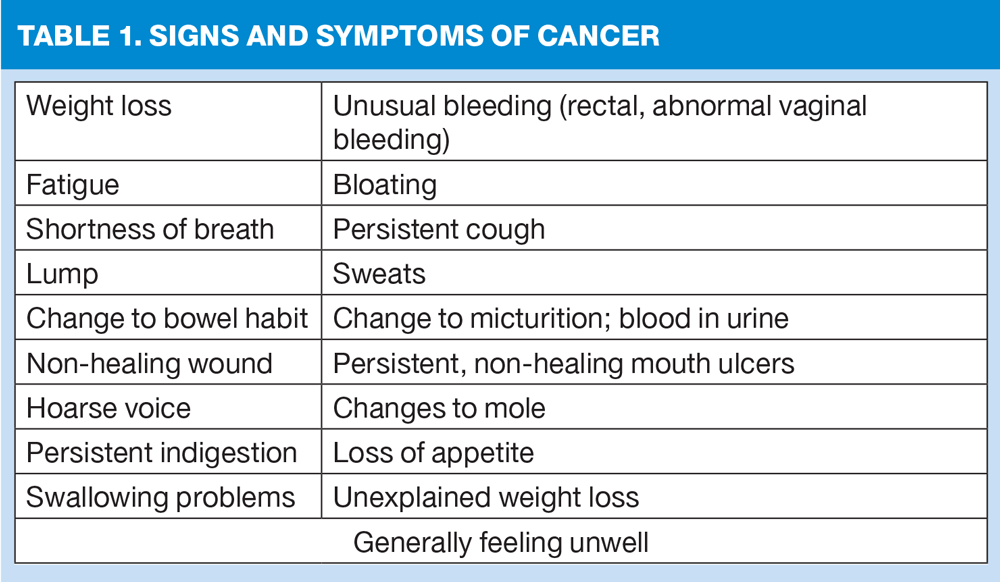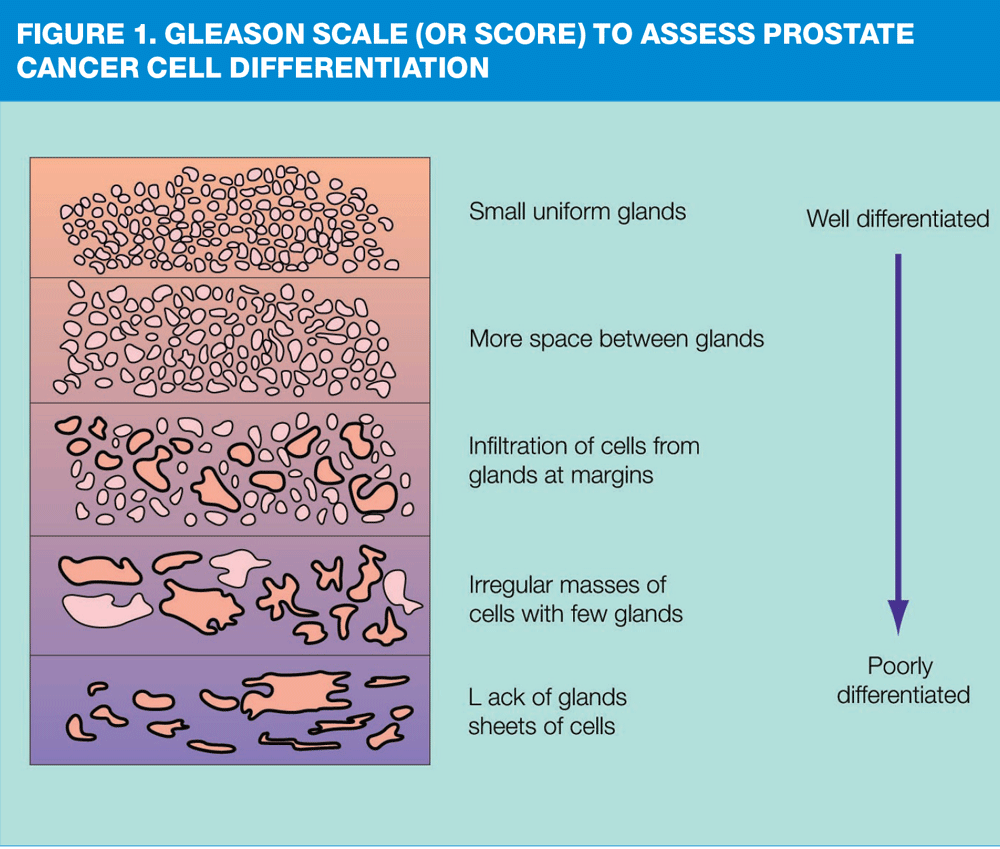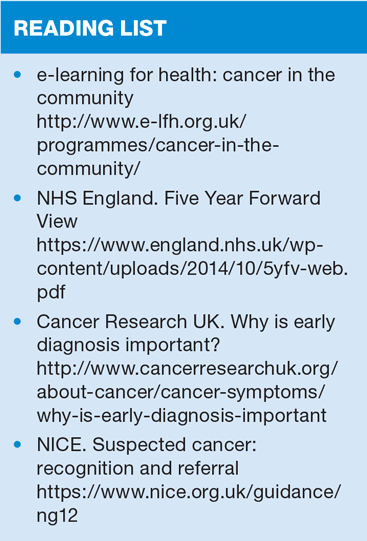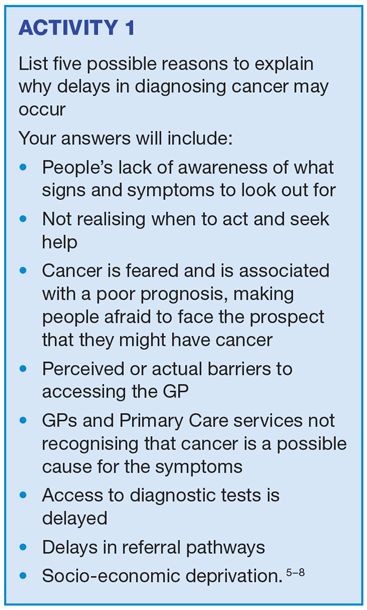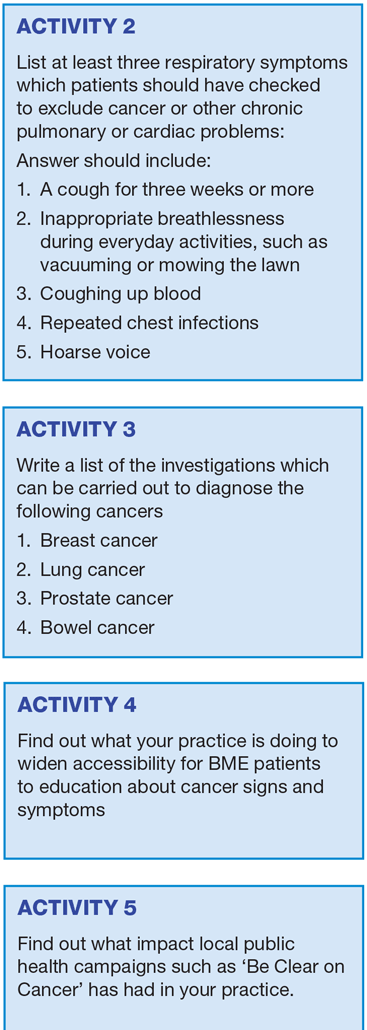
Cancer in the community: Diagnosis and staging
Catherine Wilson
Catherine Wilson
PhD MSc BSc(Hons) PgDipEd RN
Head of The Royal Marsden School, London
General practice nurses have an important role in supporting patients living with and beyond a diagnosis of cancer, and will often be asked for advice or explanations after they have seen an oncologist, simply because it is too much to take in when they receive their diagnosis. This article, the second in our series on Cancer in the Community, will focus on the diagnosis and staging of cancer. Both of these factors play an important role in treatment decisions and survival outcomes.
Cancer is a common disease, and will affect 50% of the people born after 1960 at some point in in their lifetime.1 The number of people diagnosed and living with cancer will continue to grow in the UK because there is an aging population, improved screening for some cancers and better treatments. However, the UK has relatively poor survival rates of cancer compared with other countries with well-developed healthcare systems.2,3 The main reason for this is believed to be that the UK has a high proportion of cancers that are diagnosed at an advanced stage. Consequently, the Department of Health and Public Health England have been running education and awareness-raising campaigns to try to encourage people, including professionals working in primary care to recognise the early signs and symptoms of cancer and take appropriate action.
This resource will help to increase your knowledge about the presenting signs and symptoms of cancer so that you have greater confidence to recognise them and refer patients to their GP. It will also prepare you to explain how and why cancer is staged and graded, so that you can answer patients’ questions appropriately.
AIMS AND OBJECTIVES
On completion of this resource you will have a better understanding of:
- The common signs and symptoms of cancer
- The key investigations used to diagnose cancer
- How cancer is staged and graded
WHY IS EARLY DIAGNOSIS IMPORTANT?
Cancer survival has improved significantly over past 15 years, but a major factor in the UK’s relatively poor survival rates is late diagnosis.2
Early diagnosis improves cancer survival significantly: for example, 93% of bowel cancer patients diagnosed with the earliest stage disease survive five years compared with less than 7% of those diagnosed with the most advanced disease. The same pattern is true for breast and lung cancers.4
A major concern is that 24% of patients are diagnosed with cancer following an emergency presentation.4 The average one year survival for patients presenting as emergencies is much lower than for those presenting to primary care.5 The delay in diagnosis can be for several reasons.
A research study which surveyed patients’ experiences of being diagnosed with cancer helps to explain the reasons.6 The most common reason given by patients for delaying presentation with suspicious symptoms was ‘not realising that the symptom was serious’ – cited by 27% of the respondents. A fifth (21%) of patients in the study had delayed seeking help for more than 3 months. Patients who had symptoms of prostate and rectal cancer symptoms were the most likely to have delayed attending their GP. They had ignored changes in bowel habit and generalised symptoms such as fatigue, weight loss and loss of appetite. However, patients who had other symptoms, such as blood in urine, or breast lumps had been less likely to delay seeking advice and help; these symptoms had not been ignored. The numbers of patients delaying because they were worried about what the doctor might find were very small – only 3.8% of the respondents said this; and even smaller numbers identified difficulties making an appointment or being embarrassed as reasons for delaying. This research indicates that there is a need for education and greater awareness of the signs and symptoms of cancer among the UK population.
The National Awareness and Early Diagnosis Initiative (NAEDI)4 has been running since 2008. It was launched to educate people about the signs and symptoms of early cancer and encourage people to seek help sooner. The ‘Be Clear on Cancer’ campaign was part of this initiative, aiming to raise levels of public awareness of signs and symptoms of common cancers, such as bowel, bladder and lung. The first initiative, launched in 2012, was a lung cancer campaign. Analysis of the impact identified that there was a 63% increase in people with a persistent cough aged 50 and above (the higher risk age group) who attended their GP surgery when compared with the same months in 2011. Overall, the campaign led to 700 more people being diagnosed with lung cancer; 400 of whom were diagnosed at an early stage.5
The initiatives have continued, culminating in July 2016, when a ‘respiratory symptoms’ campaign was launched, which has just ended (on 16 October). The campaign has highlighted the need for people with troublesome respiratory symptoms to visit their GP. The ‘Be Clear on Cancer’ campaign is a success story, although not all groups in society have benefited equally: people from black and ethnic minority backgrounds and the socio-economically deprived have not shown similar benefits from education campaigns.5
WHAT ARE THE SIGNS AND SYMPTOMS OF CANCER?
It is important to know which signs and symptoms of cancer might be important or significant. Often, the early signs and symptoms of cancer are quite general, for example, tiredness, a feeling of being unwell or ‘under the weather’.6 Other signs and symptoms of cancer are specific to the area where the tumour is growing, such as a lump, a change in a mole, a mouth ulcer which does not heal. Table 1 contains the most common signs of possible cancer; patients who present with these should be referred to the GP for investigation and onward review.
HOW IS CANCER DIAGNOSED?
How cancer is diagnosed depends largely on the site of the suspected malignancy.
For breast cancer, the diagnosis will be based on physical examination of the breasts, a mammogram, breast ultrasound and biopsy. If metastases are suspected, additional investigations will include chest X-Ray, CT scan, MRI scan, bone scan and liver ultrasound scan.
For suspected lung cancer the appropriate investigations are chest X-Ray and CT scan, and if necessary, bronchoscopy and/or biopsy.
The investigation of suspected prostate cancer will include a blood test (specifically Prostate Specific Antigen, PSA), digital rectal examination, biopsy and CT scan. If metastatic disease is suspected, bone scans and X-rays of specific areas of the skeleton should be carried out.
Bowel cancer investigation will include blood tests (looking for anaemia), endoscopy (gastroscopy, colonoscopy and/or sigmoidoscopy) and CT scan, and if needed, liver ultrasound.
CANCER: STAGING AND GRADING
When cancer is detected it is important to determine:
- What type it is
- How fast it is growing
- Whether or not it has invaded nearby healthy tissue/any spread to other parts of the body (i.e. if it has metastasised). This information enables the specialist team to decide on the optimal management for the patient. The staging is also important for providing information about the likely prognosis.8 For example, a large tumour, with extensive nodal involvement and metastatic spread to two or more organs suggests that the patient will probably not live as long as someone with a small tumour with no nodal involvement and no metastatic spread.
The international staging system most commonly seen is the TNM system. This refers to tumour (T), nodes (N) and metastases (M). After each letter, a number is added, to indicate the size of tumour, number of nodes involved and if the disease has spread elsewhere in the body (metastasised). For example, T2N0M0 indicates that the tumour is locally invasive, there are no lymph nodes involved and no metastases.
Cancers are also graded according to how closely they resemble the cells from which they originated. Grading is important in deciding treatment options and in estimating prognosis and likely outcome. Cancer cells which resemble their original organ are classified as ‘well differentiated’ cancers. Those which retain little resemblance to their tissue of origin and have features of aggressive growth and high rates of cell division are graded as ‘poorly differentiated’ cancers and these generally carry a worse prognosis.7 See Table 2
However, a high grade tumour does not mean the cancer is terminal; aggressive cancers are often highly sensitive to treatment.
Some cancers are also classified in terms of hormonal status and other specific receptors, since this information guides the treatment choices available. For example, breast cancer is classified in terms of its hormone receptor status (oestrogen and progesterone) and Herceptin receptor status. A breast cancer which is oestrogen and progesterone receptor positive will have its growth inhibited if these hormones are suppressed – which is why many women with oestrogen and progesterone receptor positive breast cancer will be prescribed Tamoxifen.
Herceptin receptors on the breast cancer enable Herceptin to be administered. The link will take you to an explanation of the role of Herceptin receptors with specific reference to their role in the management of metastatic breast cancer https://www.youtube.com/watch?v=Q3Tzc3jGt3U
Bowel cancers are sometimes classified according to the Duke’s Classification system. The link below will take you to the Cancer Research UK website to explain this in more detail: http://www.cancerresearchuk.org/about-cancer/type/bowel-cancer/treatment/dukes-stages-of-bowel-cancer#dukes
Prostate cancers will also be given a Gleason score, to indicate the degree of differentiation. (Figure 1). See also Cancer Research UK website: http://www.cancerresearchuk.org/about-cancer/type/prostate-cancer/treatment/types/factors-in-deciding-treatment-for-prostate-cancer
Once a patient has been diagnosed with cancer, their care is managed by a specialist multi-disciplinary team (MDT), comprised of the oncologists, a surgeon, a pathologist, radiologist, clinical nurse specialist and other specialists relevant to the specific cancer (e.g. haematologist). The MDT discusses each newly-diagnosed patient’s signs, symptoms, pathology grading, likely prognosis and then make treatment decisions based on the evidence and recommendations from National Institute of Health and Care Excellence (NICE).
In order to improve the diagnosis of cancer, there are strict two-week target times for primary care teams to refer patients for specialist investigations and appointments. Patients will be informed that they are being referred on a ‘two week pathway’ in view of their worrying symptoms. The target is to commence treatment within two months after an urgent GP referral has been sent to the hospital for suspected cancer. Once a patient has been diagnosed with cancer, the target is to ensure treatment is commenced no more than 31 days after the treatment plan has been agreed between the specialist and the patient.
CONCLUSION
Waiting for a diagnosis, for test results and to commence treatment are times of worry and stress. It is difficult to offer appropriate support, especially if the situation remains uncertain. Listening to patients, and being empathetic are helpful strategies: acknowledging how difficult this time is will also help.
PRACTICE NURSE FEATURED ARTICLES
Catherine Wilson. Cancer in the community: Cancer screening Practice Nurse, September 2016
Tessa Watts. Primary breast cancer: what do practice nurses need to know, Practice Nurse February 2013
Jim Pollard. Prostate cancer and the practice nurse. Practice Nurse, November 2014
Before undertaking this learning activity, you might find it helpful to remind yourself of how cancers develop. Follow the link for a video clip which explains it: https://www.youtube.com/watch?v=46Xh7OFkkCE
TEST YOUR KNOWLEDGE
Complete the following questions then scroll down to check your answers
Q1
Mrs Smith has a leg ulcer, which you are dressing, and you know that she has been seen at the hospital in recent weeks to be investigated for a large breast lump. At the end of her dressing change, she brings a letter out of her handbag to show you, and asks you what you think.
The letter states that she has: Breast cancer T4N3M1
a) What does this mean?
b) List four organs of the body where breast cancer usually metastasises
c) List six signs of abnormality in the breast which should trigger referral to GP/breast clinic
Q2
Recognising early non-specific symptoms of possible cancer is important. Look out for patients who have a cluster of seemingly insignificant symptoms.
How confident are you that you could identify suspicious symptoms in the following cancers?
a) List three symptoms which might indicate cervical cancer
b) List three symptoms which might indicate ovarian cancer
c) List three symptoms which might indicate bowel cancer
Visit Cancer Research UK website for more information on signs and symptoms of specific cancers http://www.cancerresearchuk.org/about-cancer/type/
Q3
Jenny tells you she is going to have a PET-CT scan, and is not sure what this involves.
a) How confident are you to be able to explain this scan to Jenny?
Look at the link to find out more about PET-CT scans: http://www.cancerresearchuk.org/about-cancer/cancers-in-general/tests/petct-scan and watch the video
b) What information will this scan NOT be expected to provide? Select one of the answers below
1. Cellular activity, including tumour activity
2. A 3-D image of the tumour
3. Images of blood flow to the tumour in real-time
4. Precise sizing of the tumour and its spread to local tissues
Q4
List four common diagnostic investigations for cancer. Are you confident that you know what is involved in each of these, and would be able to explain the test to patients if they asked you for more information?
The Cancer Research UK website includes details of the techniques and tests used to diagnose cancer. Have a look at the list, and update your knowledge so that you can feel confident to explain and support patients who are undergoing investigations and staging tests for cancer.
REFERENCES
1. Cancer Research UK 2015 http://www.cancerresearchuk.org/health-professional/cancer-statistics/incidence#heading-One Accessed September 30th 2016
2. Independent Cancer Taskforce (2015) Achieving World-Class Cancer Outcomes: A Strategy for England 2015-2020 Department of Health http://www.cancerresearchuk.org/sites/default/files/achieving_world-class_cancer_outcomes_-_a_strategy_for_england_2015-2020.pdf
3. Neal RD, Tharmanathan P, France B, et al. Is increased time to diagnosis and treatment in symptomatic cancer associated with poorer outcomes: a systematic review. British Journal of Cancer 2015;112:S92-S107
4. National Awareness and Early Diagnosis Initiative (2008) Public Awareness of Cancer in Britain: A Report for the NAEDI
5. Hiom SC, (2015): Diagnosing cancer earlier: reviewing the evidence for improving cancer survival. British Journal of Cancer 2015;112:S1-S5
6. Forbes L J, Warburton F, Richards MA, et al. Risk factors for delay in symptomatic presentation: a survey of cancer patients. British Journal of Cancer 2014;111(3):581-588.
7. Neal AJ, Hoskin PJ. Clinical Oncology (4th ed). 2009; London: Hodder Arnold.
8. Quaife SL, Forbes LJL, Ramirez A J, et al. Recognition of cancer warning signs and anticipated delay in help-seeking in a population sample of adults in the UK. British Journal of Cancer 2014;110(1):12-18.
9. Almeida CA, Barry SA. Cancer: Basic science and clinical aspects. 2009; London:Wiley-Blackwell
ANSWERS
Q1
b) The breast cancer is at Stage 4 – the tumour is large; there are multiple lymph nodes involved and the cancer has spread to one or more organ. See the following web page for more detailed explanation: https://www.breastcancercare.org.uk/information-support/facing-breast-cancer/diagnosed-breast-cancer/diagnosis/cancer-stages
c) Bone
Liver
Lung
Brain
c) Change in size or shape of the breast
A lump or thickening in the breast
Redness or a rash on the skin and/or around the nipple
Peau d’orange (a change in skin texture such as puckering or dimpling, like orange peel)
Discharge from the nipple
Inverted nipple
Q2
a) Post-coital bleeding; post-menopausal bleeding; inter-menstrual bleeding
b) Abdominal bloating; persistent pelvic and abdominal pain; difficulty eating and feeling full quickly
c) Change in bowel habit; blood in stool; weight loss
Q3
b) Images of blood flow to the tumour in real-time
Q4
Your list will include:
X Ray
Ultrasound
CT scan
Endoscopies (gastroscopy; colonoscopy; sigmoidoscopy)
PET-CT scan
MRI scan
Bone scan
Bone marrow aspirate and trephine
Related articles
View all Articles
